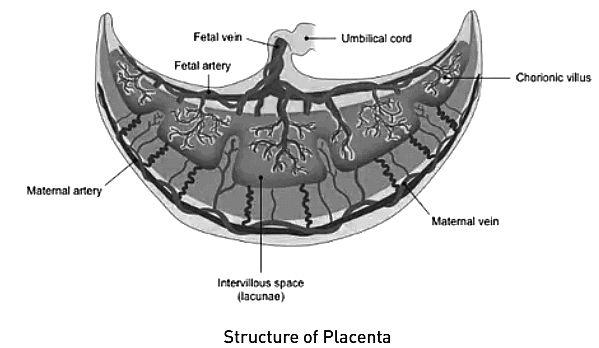UPSC Exam > UPSC Notes > Zoology Optional Notes for UPSC > Placenta (Structure, types and functions of placenta)
Placenta (Structure, types and functions of placenta) | Zoology Optional Notes for UPSC PDF Download
| Table of contents |

|
| Definition and Characteristics |

|
| Structure of Placenta |

|
| Types of Placenta |

|
| Function of the Placenta |

|
| Purpose of the Placenta |

|
Definition and Characteristics
Definition of Placenta:
- The placenta is a transient organ crucial for nourishing and safeguarding the fetus during pregnancy. It develops alongside the fetus and is expelled during childbirth.
- It is colloquially known as the "afterbirth" due to its expulsion after delivery.
Transient Circulatory Organ:
- The placenta, unique to mammals, serves as a temporary circulatory organ connecting the fetal and maternal systems during pregnancy.
- The umbilical cord links the fetus to the placenta, facilitating the transfer of materials.
Attachment to Uterus:
- The placenta is typically attached to various parts of the uterus, including the top, bottom, side, front, or back.
- An abnormal attachment, such as in placenta previa, can pose serious complications during pregnancy.

Structure of Placenta
Finger-like Projections (Chorionic Villi):
- Chorionic villi, projections from the chorion's outer surface, infiltrate the uterine tissue, forming the placenta.
- This connective tissue serves as both embryonic and maternal, facilitating material exchange.
Role in Nutrient Exchange:
- The developing embryo receives oxygen and nutrients from the mother through the placenta.
- Simultaneously, waste products like carbon dioxide and nitrogenous waste are eliminated.

Types of Placenta
Based on Embryonic Tissue Involvement:
- Yolk-Sac Placenta and Chorio-Allantok Placenta are classified based on the embryonic tissue's interaction with the uterine wall.
Villi Distribution:
- Diffused, Cotyledonary, Zonary, and Discoidal Placenta exhibit variations in the distribution and formation of villi.
Villi's Relationship with Uterine Wall:
- Deciduate and Indeciduate (Adeciduate) Placenta differ in the degree of villi attachment to the uterine wall and their persistence after birth.
Degree of Tissue Involvement:
- Epitheliochorial, Haemochorial, Haemoendothelial, and Syndesmochorial Placenta are distinguished by the involvement of fetal and maternal tissues.
 |
Download the notes
Placenta (Structure, types and functions of placenta)
|
Download as PDF |
Download as PDF
Function of the Placenta
Life Support Functions:
- Gas exchange, nutrient acquisition, and waste removal are essential functions ensuring the fetus's well-being.
Barrier and Immunological Functions:
- The placenta acts as a barrier, protecting the fetus from infections and filtering out potential threats.
- Immunological protection is provided through the transfer of antibodies from the mother to the fetus.
Endocrine Function:
- The placenta secretes hormones (estrogen, progesterone, HCG), maintaining a pregnancy-ready state in the mother.

Purpose of the Placenta
Nutrition and Storage:
- Nutrient transfer from maternal to fetal blood, storage of glycogen and nutrients before liver development.
Endocrine Secretion:
- The placenta functions as an endocrine gland, secreting hormones vital for pregnancy.
Protein Digestion and Excretion:
- Trophoblasts in the placenta break down proteins for fetal circulation, and it aids in excreting nitrogenous wastes.
Respiration and Barrier Function:
- Oxygen and carbon dioxide exchange between fetal and maternal blood, and the placenta acts as a barrier against harmful substances.
Understanding the multifaceted roles and structures of the placenta is crucial for comprehending its significance in fetal development and maternal-fetal interactions.
The document Placenta (Structure, types and functions of placenta) | Zoology Optional Notes for UPSC is a part of the UPSC Course Zoology Optional Notes for UPSC.
All you need of UPSC at this link: UPSC
|
181 videos|346 docs
|
Related Searches




















